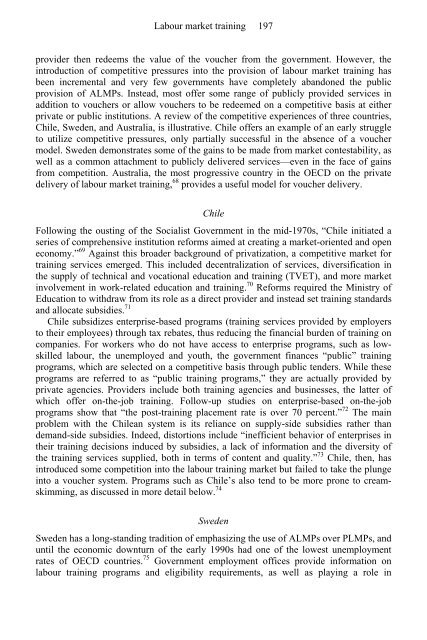Rethinking the Welfare State: The prospects for ... - e-Library
Rethinking the Welfare State: The prospects for ... - e-Library
Rethinking the Welfare State: The prospects for ... - e-Library
You also want an ePaper? Increase the reach of your titles
YUMPU automatically turns print PDFs into web optimized ePapers that Google loves.
Labour market training 197<br />
provider <strong>the</strong>n redeems <strong>the</strong> value of <strong>the</strong> voucher from <strong>the</strong> government. However, <strong>the</strong><br />
introduction of competitive pressures into <strong>the</strong> provision of labour market training has<br />
been incremental and very few governments have completely abandoned <strong>the</strong> public<br />
provision of ALMPs. Instead, most offer some range of publicly provided services in<br />
addition to vouchers or allow vouchers to be redeemed on a competitive basis at ei<strong>the</strong>r<br />
private or public institutions. A review of <strong>the</strong> competitive experiences of three countries,<br />
Chile, Sweden, and Australia, is illustrative. Chile offers an example of an early struggle<br />
to utilize competitive pressures, only partially successful in <strong>the</strong> absence of a voucher<br />
model. Sweden demonstrates some of <strong>the</strong> gains to be made from market contestability, as<br />
well as a common attachment to publicly delivered services—even in <strong>the</strong> face of gains<br />
from competition. Australia, <strong>the</strong> most progressive country in <strong>the</strong> OECD on <strong>the</strong> private<br />
delivery of labour market training, 68 provides a useful model <strong>for</strong> voucher delivery.<br />
Chile<br />
Following <strong>the</strong> ousting of <strong>the</strong> Socialist Government in <strong>the</strong> mid-1970s, “Chile initiated a<br />
series of comprehensive institution re<strong>for</strong>ms aimed at creating a market-oriented and open<br />
economy.” 69 Against this broader background of privatization, a competitive market <strong>for</strong><br />
training services emerged. This included decentralization of services, diversification in<br />
<strong>the</strong> supply of technical and vocational education and training (TVET), and more market<br />
involvement in work-related education and training. 70 Re<strong>for</strong>ms required <strong>the</strong> Ministry of<br />
Education to withdraw from its role as a direct provider and instead set training standards<br />
and allocate subsidies. 71<br />
Chile subsidizes enterprise-based programs (training services provided by employers<br />
to <strong>the</strong>ir employees) through tax rebates, thus reducing <strong>the</strong> financial burden of training on<br />
companies. For workers who do not have access to enterprise programs, such as lowskilled<br />
labour, <strong>the</strong> unemployed and youth, <strong>the</strong> government finances “public” training<br />
programs, which are selected on a competitive basis through public tenders. While <strong>the</strong>se<br />
programs are referred to as “public training programs,” <strong>the</strong>y are actually provided by<br />
private agencies. Providers include both training agencies and businesses, <strong>the</strong> latter of<br />
which offer on-<strong>the</strong>-job training. Follow-up studies on enterprise-based on-<strong>the</strong>-job<br />
programs show that “<strong>the</strong> post-training placement rate is over 70 percent.” 72 <strong>The</strong> main<br />
problem with <strong>the</strong> Chilean system is its reliance on supply-side subsidies ra<strong>the</strong>r than<br />
demand-side subsidies. Indeed, distortions include “inefficient behavior of enterprises in<br />
<strong>the</strong>ir training decisions induced by subsidies, a lack of in<strong>for</strong>mation and <strong>the</strong> diversity of<br />
<strong>the</strong> training services supplied, both in terms of content and quality.” 73 Chile, <strong>the</strong>n, has<br />
introduced some competition into <strong>the</strong> labour training market but failed to take <strong>the</strong> plunge<br />
into a voucher system. Programs such as Chile’s also tend to be more prone to creamskimming,<br />
as discussed in more detail below. 74<br />
Sweden<br />
Sweden has a long-standing tradition of emphasizing <strong>the</strong> use of ALMPs over PLMPs, and<br />
until <strong>the</strong> economic downturn of <strong>the</strong> early 1990s had one of <strong>the</strong> lowest unemployment<br />
rates of OECD countries. 75 Government employment offices provide in<strong>for</strong>mation on<br />
labour training programs and eligibility requirements, as well as playing a role in


